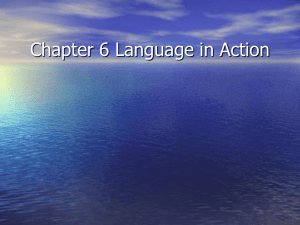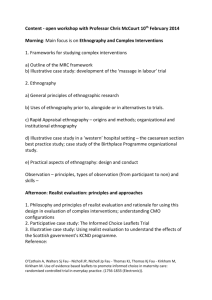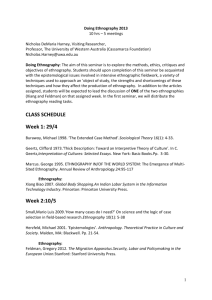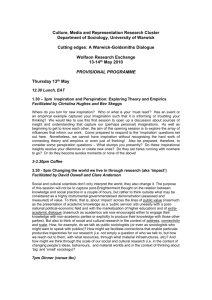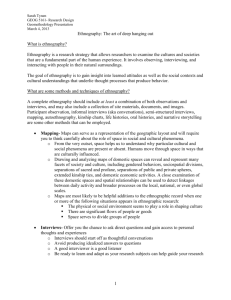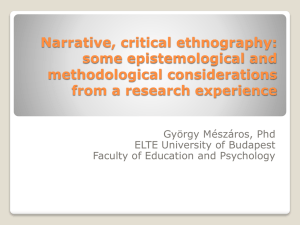Contextual Components & Communicative Interactions
advertisement
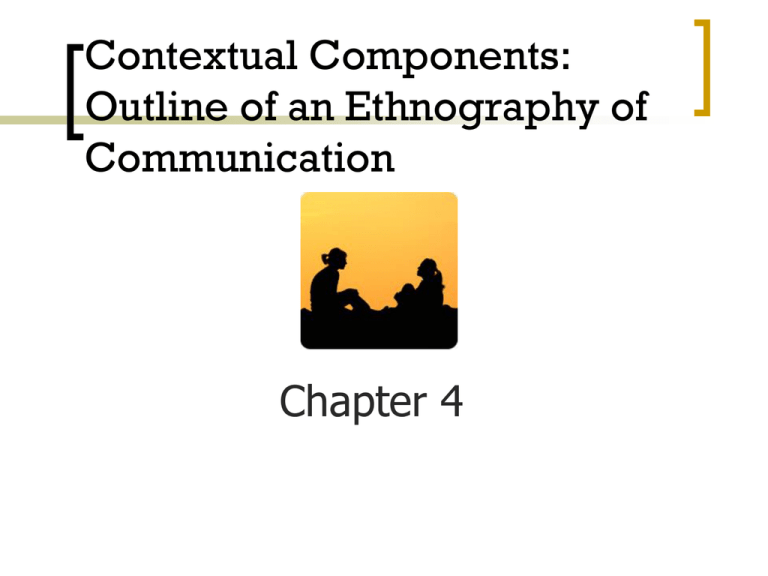
Contextual Components: Outline of an Ethnography of Communication Chapter 4 Language in Context Context = cultural and social situation How does context affect language? Malinowski (1884-1942) Translation requires knowledge of context Context can shift meanings Indirection Saving Face. Communicative Competence Ability to speak a language “well” Ability to use your language “correctly” In a variety of social situations Compare with Linguistic Competence Ability to produce (and recognize) grammatically correct expressions Chomsky’s “ideal speaker” Not distracted by environment. Some Environmental “Distractions” When ‘bad’ means ‘good’ When is not appropriate to respond honestly Different words/expressions among cultures/subcultures Greetings and address terms ‘Hello’ / ‘Hi’ / ‘Sup!’ Usted vs. tu, vosotros/vois How do you learn these “rules?” Ethnography of Speaking…. Ethnography of Speaking Developed in 1960s by Dell Hymes Focus on language in total cultural context How people use language in real situations Communicative competence The importance of fieldwork What are the rules for speaking? For not speaking? How do children learn the rules?. Ethnography of SPEAKING Setting/Situation/Scene Participants Where? Who are the speakers? Who can speak? Who should speak? Ends: What are the goals? Bargaining Asking for (and giving) directions Report-talk vs rapport-talk. Ethnography of SPEAKING Act Sequence Exactly what gets said? Speech Acts Speech Events Exchanging greetings, telling jokes, giving speeches Status and type or order of greetings Speech Situations Promises, commands, apologies Classrooms, conferences, parties, ceremonies Key Tone of voice, manner of delivery Mourning, joking, irony, teasing. Ethnography of SPEAKING Instrumentalities Languages & dialects Mutual intelligibility Politics and attitudes: languages and their speakers Ideas about “Standard” and “Non-standard” Cousin Joe and the performance of identity thru dialect ‘warsh’ ‘fouath flouah’ ‘pahking the cah’ “A language is a dialect with an army and navy.” Ethnography of SPEAKING Norms Expectations Speaking vs silence Directness vs indirectness Lying vs politeness Taking turns and interrupting Taboos and avoidances Genres Kinds of speech acts or events Lectures, Poetry Readings, Joking, Gossip. Speech Communities Linguistic Communities A speech community is A group of people who share A linguistic community is A group of people who share One or more varieties of language And the rules for using them in interaction A single language variety And who identify with that language variety A community of practice is ???. Language Across Cultures Different communities = different rules Easy for misunderstandings to occur Rich Points Moments of misunderstanding Corn pudding Interviewing for a job Asking for a ride Signal differences in rules Ways to say ‘no’ Ways to take turns Indirectness. Communicative Interactions Chapter 5 Structural Properties of Conversation Speakers have options of ways to express themselves. Conversational interaction Turn-taking Influence of context Sensitive to status of participants Turn-constructional units Adjacency pairs Tag questions Turn-entry devices Active Listening Eye-contact Paraphrasing Acknowledgement Using I vs. You messages Function? Politeness Cross Cultural Repairs Michael Agar’s ‘MAR’ Recognize/acknowledge ‘Mistake’ in using rules Develop Awareness of different rules Ethnography of Communication as a method Repair understanding of rules Finding appropriate ways to say ‘no’ Learning to take turns without ‘interrupting’ ‘Hearing’ and responding to a request for a ride.
